| Article ID | Journal | Published Year | Pages | File Type |
|---|---|---|---|---|
| 6327778 | Science of The Total Environment | 2015 | 8 Pages |
Abstract
This study focuses on the uses of the electrical tomography and its relationship with hydrochemical data in order to characterize contaminated groundwater flows in fractured aquifers. The studied area is contaminated with different hazardous substances like lyndanes, organochlorinated compounds and benzenes coming from the old non-controlled Sardas landfill. The enormous volumes of wastes filling the landfill have generated a convoluted mixture of leachates. Due to the lack of a landfill liner, the leachates have migrated through the fractured Eocene marls towards the Gallego River. The striking correlation between high concentrations of polluted groundwater and low electrical resistivity of the subsurface (< 8 Ω·m) allows defining the principal contaminant migration route thanks to the distribution of these conductive anomalies. This mapping verifies that there is intense tectonical-structural control of the leachate migration, because the deep migration presents the same direction as the geological axis fold.
Related Topics
Life Sciences
Environmental Science
Environmental Chemistry
Authors
Ismael Casado, Himi Mahjoub, Raul Lovera, Jesús Fernández, Albert Casas,
